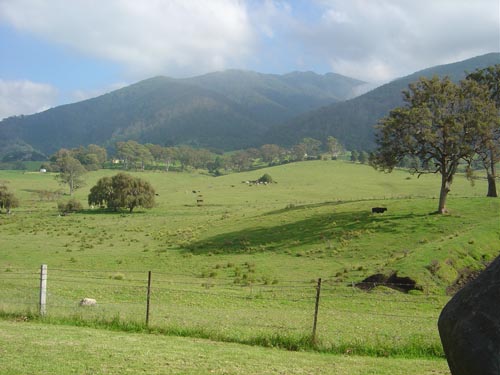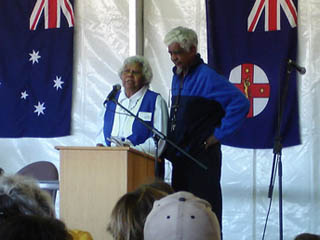
Working together through joint management -
Gulaga and Biamanga National Parks
Aboriginal people are now involved in the management of their parks.
To manage our sites we know best what they mean.
We know best how to manage Aboriginal sites ... That’s why
it’s important that we are on the Board of Managment for Gulaga.
Trisha Ellis
Sitting beside the visitors information kiosk on Gulaga Mountain, Trisha Ellis, reflects on the conclusion of many years of hard work to bring about joint management of Gulaga and Biamanga National Parks.
Trisha Ellis, Joint Management Coordinator, Department of Environment and Climate Change (DECC) NSW. Filmed in 2007. |
Look, and it’s ours again, and it’s the most magnificent place! On a personal level, I think it’s just amazing. This is for my mother and my grandmother and my aunties, you know… All my old aunties, my ancestors. Everyone who’s gone before us. The struggle to get things back to Aboriginal people didn’t start yesterday, it started over two hundred years ago, so...
A history of the handback of Gulaga and Biamanga National Parks
In 1977, Yuin Elders, Guboo Ted Thomas, Jack Campbell and
Percy Mumbler, launched a protest about logging on Biamanga, then known
as Mumbulla Mountain. As logging activities intensified, claims were made
to have both Biamanga and Gulaga (then Mt Dromedary) recognised as Aboriginal
sites of significance. Both mountains are sacred for Yuin people: Biamanga
was a traditional site of men's initiation ceremonies and Gulaga is known
as
the women's mountain.
During the 1970s and 1980s, the New South Wales government passed legislation to enable recognition of the original Aboriginal ownership of lands: the National Parks and Wildlife Act 1974 (NSW) and the Aboriginal Land Rights Act 1983 (NSW). For joint management, land must be listed on Schedule 14 of the National Parks and Wildlife Act 1974. Biamanga National Park was listed in 1998 and Gulaga National Park in 2001.
|
 Gulaga Gulaga |
From that time on, the Office of the Registrar of the Aboriginal Land Rights Act 1983 (NSW) began identifying traditional owners who would be eligible to elect a Board of Management that could work with the NSW National Parks and Wildlife Service to manage Gulaga and Biamanga National Parks. In 2007, the Minister for the Environment appointed the Boards of Management. |
|
